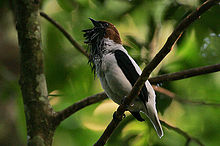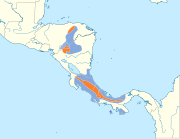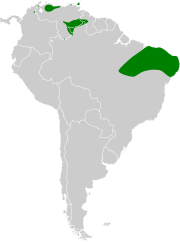
Pachyptila is a genus of seabirds in the family Procellariidae and the order Procellariiformes. The members of this genus and the blue petrel form a sub-group called prions. They range throughout the southern hemisphere, often in the much cooler higher latitudes. Three species, the broad-billed prion, the Antarctic prion and the fairy prion, range into the subtropics.

The cotingas are a large family, Cotingidae, of suboscine passerine birds found in Central America and tropical South America. Cotingas are birds of forests or forest edges, that are primary frugivorous. They all have broad bills with hooked tips, rounded wings, and strong legs. They range in size from 12–13 cm (4.7–5.1 in) of the fiery-throated fruiteater up to 48–51 cm (19–20 in) of the Amazonian umbrellabird.

The bearded bellbird, also known as the campanero or anvil-bird, is a passerine bird which occurs in northern South America. The male is about 28 cm (11 in) long with white plumage apart from a brown head and black wings. At his throat hang several black, unfeathered wattles. The female is a little smaller with olive-green head and upper parts, yellow underparts streaked with green and a yellow vent area. The male has a loud, repeated metallic hammering call, as well as various other vocalisations.

Umbrellabird is the common name referring to three species of birds in the genus Cephalopterus. They are named for their distinct umbrella-like hoods.

The double-striped thick-knee is a stone-curlew, a group of waders in the family Burhinidae. The vernacular name refers to the prominent joints in the long greenish-grey legs, and bistriatus to the two stripes of the head pattern.

An aracari or araçari is any of the medium-sized toucans that, together with the saffron toucanet, make up the genus Pteroglossus.

A coucal is one of about 30 species of birds in the cuckoo family. All of them belong in the subfamily Centropodinae and the genus Centropus. Unlike many Old World cuckoos, coucals are not brood parasites, though they do have their own reproductive peculiarity: all members of the genus are sex-role reversed, so that the smaller male provides most of the parental care. Male pheasant coucals invest in building the nest, incubate for the most part and take a major role in feeding the young. At least one coucal species, the black coucal, is polyandrous.

The three-wattled bellbird is a Central American migratory bird of the cotinga family. The sexes are very dissimilar in appearance. The male has a white head and throat and the remaining plumage is chestnut brown. From the base of his beak dangle three long, slender, black wattles that he uses in display. The female has olive plumage with yellowish streaked underparts and a yellow vent area.

The long-wattled umbrellabird is an umbrellabird in the Cotingidae family. Its Spanish names include pájaro bolsón, pájaro toro, dungali, and vaca del monte. The long-wattled umbrellabird is considered rare and it resides in humid to wet premontane and cloud forest. They are often found on the Pacific slopes of southwest Colombia and western Ecuador, but occasionally are found at lower altitudes.
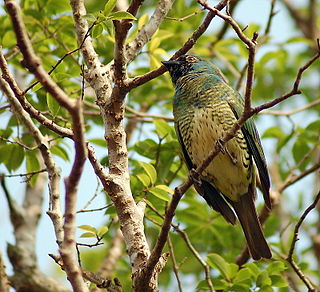
The swallow tanager is a species of Neotropic bird in the tanager family Thraupidae. It is the only member of the genus Tersina. It is found widely throughout South America, from eastern Panama to far northern Argentina. The species is sexually dimorphic: the female is a yellow-green and the male a turquoise blue with a small deep black face and upper throat patch.

The kinglet calyptura is a small passerine bird. It is the only member of the genus Calyptura in the family Tyrannidae. It had traditionally been considered a member of the family Cotingidae. It is endemic to Atlantic forest in south-eastern Brazil. For a long time this species was feared to be extinct, as it went unrecorded during the 20th century until two birds were observed in Serra dos Órgãos on several days in October 1996. Since these sightings, there have not been any confirmed records, although at least one recent—but unconfirmed—record exists from near Ubatuba. Consequently, it is considered Critically Endangered by BirdLife International.

Lipaugus is a genus of birds in the family Cotingidae.

A becard is a bird of the genus Pachyramphus in the family Tityridae.

Phoenicircus is a genus of birds in the family Cotingidae. They have a bright red breast, crown, tail, and rump with the Guianan species having dark brown wings and the black-necked species having black wings. They are frugivores, eating primarily berries and drupes.
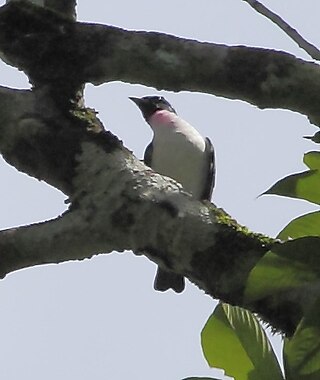
The purple-throated cotinga is a species of bird in the cotinga family, Cotingidae. It is found in the western Amazon rainforest of South America; its range extends from southern Colombia south through eastern Ecuador and Peru and east through extreme northwestern Bolivia and into western Amazonian Brazil. It lives in the canopy or along the borders of humid forest throughout its range. The purple-throated cotinga is monotypic within the genus Porphyrolaema and has no known subspecies. It is one of the smaller cotinga species and expresses strong sexual dimorphism. Males have black upperparts with a bold white wingstripe and white edges to the tertial feathers and a white belly with some black barring on the rear flanks. The throat is a deep purple, giving the bird both its common and scientific names. Females are dark brown with pale buffy margins on the upperparts, buffy cinnamon with black barring on the underparts, and rufous on the throat. The male has a powerful voice.

The white bellbird is a species of bird in the family Cotingidae. It is the world’s loudest bird, producing vocalizations of up to 125.4 decibels. The specific epithet is often spelled alba, but albus is correct due to the masculine gender of "Procnias". It is found in forests in the Guianas, with small numbers in Venezuela and the Brazilian state of Pará, as well as Trinidad and Tobago and Panama. As in two other members of Procnias, the males have wattles, fleshy structures akin to the red skin flap that hangs from the throat of roosters.
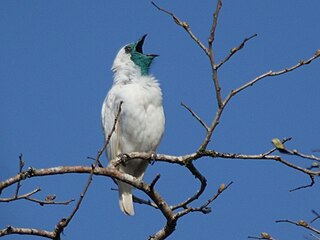
The bare-throated bellbird is a species of bird in the family Cotingidae. It is found in moist subtropical and tropical forests in Argentina, Brazil, and Paraguay. The male has white plumage and bristly bluish-black bare skin around its eye, beak and throat. The female is more drab, being olive-brown above with streaked yellow underparts. The male has one of the loudest known bird calls, producing a metallic sound similar to a hammer striking an anvil. This bird feeds strictly on fruit and plays a part in dispersing the seeds of forest trees. It is considered Near Threatened because of loss of its forest habitat and collection for the pet bird trade

The Peruvian thick-knee is a species of bird in the family Burhinidae. It is found in Chile, Ecuador, and Peru. Its natural habitats are subtropical or tropical dry shrubland, subtropical or tropical seasonally wet or flooded lowland grassland, and pastureland. It is a ground-dwelling bird and feeds on insects and small animals.

Tityridae is family of suboscine passerine birds found in forest and woodland in the Neotropics. The 45 species in this family were formerly spread over the families Tyrannidae, Pipridae and Cotingidae. As yet, no widely accepted common name exists for the family, although tityras and allies and tityras, mourners and allies have been used. They are small to medium-sized birds. Under current classification, the family ranges in size from the buff-throated purpletuft, at 9.5 cm (3.7 in) and 10 grams, to the masked tityra, at up to 24 cm (9.5 in) and 88 grams. Most have relatively short tails and large heads.
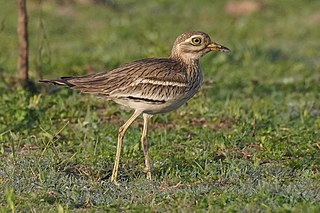
The Indian stone-curlew or Indian thick-knee is a species of bird in the family Burhinidae. It was formerly included as a subspecies of the Eurasian stone-curlew. This species is found in the plains of South and South-eastern Asia. They have large eyes and are brown with streaks and pale marks making it hard to spot against the background of soils and rocks. Mostly active in the dark, they produce calls similar to the true curlews, giving them their names.
